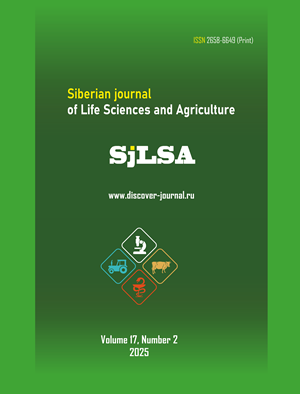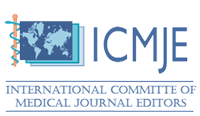Послеубойная диагностика пастереллеза свиней
Аннотация
Обоснование. В связи с широким распространением пастереллеза среди свиней и огромным экономическим ущербом, которое наносит это заболевание свиноводческим хозяйствам (значительный падеж поголовья, затраты на лечение, снижение качества животноводческой продукции и опасность заражения людей), проблема диагностики пастереллеза является актуальной задачей ветеринарной науки.
Цель. Целью наших исследований являлось проведение послеубойной диагностики пастереллеза в трех свиноводческих хозяйствах Армавирской области Республики Армения, идентифицирование его возбудителя для последующей организации лечебно-профилактических мероприятий.
Материал и методы. Исследования проводились на поголовье свиней трех свиноводческих хозяйств Армавирской области, подвергнутых убою. Проводился послеубойный осмотр легких животных для изучения характера поражений этого органа, была определена средняя масса, подвергнутых убою свиней. Из пораженных участков легких был отобран патологический материал, который был использован для культивирования и идентификации возбудителя. Идентификацию возбудителя проводили на кровяном агаре, а также на агаре Mac Conkey. Определение биохимических свойств возбудителя осуществляли с использованием биохимических тестов API 20E.
Результаты. У 74, подвергнутых убою свиней, были обнаружены патологоанотомические изменения в легких, характерные для крупозной, серозно-фибринозной пневмонии, фибрино-некротической плевропневмонии, плевриту и бронхопневмонии. Масса тела, подвергнутых убою животных, у которых наблюдалось поражение легких, была снижена. При посеве на МПА, содержащий 5℅ сыворотку крови, были обнаружены колонии, характерные по морфологическим свойствам на колонии пастерелл. Биохимические исследования подтвердили принадлежность возбудителя к виду P. multocida.
Заключение. При исследовании легких животных, подвергнутых убою, наблюдались явления пневмонии, плевропнемонии и плеврита. При посеве на питательные среды был идетифицирован возбудитель P. Multocida. Обобщая результаты исследований, можно отметить, что пастереллез имеет значительное распространение у свиней и сопровождается поражением легких.
Информация о спонсорстве. Работа выполнена по решению правительства Республики Армения по базовому финансированию научных тем в Армении.
EDN: FBSWNB
Скачивания
Литература
Kimura, R., Hayashi, Y., Takeuchi, T., Shimizu, M., Iwata, M., Tanahashi, J., & Ito, M. (2004). Pasteurella multocida septicemia caused by close contact with a domestic cat: case report and literature review. J Infect Chemother, 10(4), 250-252. https://doi.org/10.1007/s10156-004-0331-5
Лях, Ю. Г. (2013). Пастереллез свиней и крупного рогатого скота. Минск: ООО «Инфофорум», 212 с. (Lyakh, Yu. G. (2013). Pasteurellosis of pigs and cattle. Minsk: Inforum. 212 p.)
Лях, Ю. Г., Синица, О. Н. (2000). Пневмонии пастереллезно-сальмонеллезной этиологии молодняка сельскохозяйственных животных в Республике Беларусь и их специфическая профилактика. Международный аграрный журнал, 9, 42-44. (Lyakh, Yu. G., & Sinitsa, O. N. (2000). Pneumonia of pasteurella-salmonella etiology in young farm animals in the Republic of Belarus and their specific prevention. International Agricultural Journal, 9, 42-44.) EDN: https://elibrary.ru/ytupcs
Немкова, Н. П. (2017). Ветеринарно-санитарная экспертиза продуктов убоя животных при инфекционных болезнях: Методические указания. Красноярск, 73 с. (Nemkova, N. P. (2017). Veterinary and sanitary examination of slaughter products of animals with infectious diseases: Methodical instructions. Krasnoyarsk. 73 p.) EDN: https://elibrary.ru/gdgzpy
Bardou, M., Honnorat, E., Dubourg, G., Couderc, C., Fournier, P. E., Seng, P., & Stein, A. (2015). Meningitis caused by Pasteurella multocida in a dog owner without a dog bite: clonal lineage identification by MALDI-TOF mass spectrometry. BMC Res Notes, 8, 626. https://doi.org/10.1186/s13104-015-1615-9
Becskei, Z., Aleksić-Kovačević, S., Rusvai, M., Balka, G., Jakab, C., Petrović, T., & Knežević, M. (2010). Distribution of porcine circovirus 2 cap antigen in the lymphoid tissue of pigs affected by postweaning multisystemic wasting syndrome. Acta Vet Hung, 58(4), 483-498. https://doi.org/10.1556/AVet.58.2010.4.9
Blackall, P. J., Pahoff, J. L., & Bowles, R. (1997). Phenotypic characterisation of Pasteurella multocida isolates from Australian pigs. Vet Microbiol, 57(4), 355-360. https://doi.org/10.1016/s0378-1135(97)00111-9
Boyanton, B. L. Jr., Freij, B. J., Robinson-Dunn, B., Makin, J., Runge, J. K., & Luna, R. A. (2016). Neonatal Pasteurella multocida subsp. septica Meningitis Traced to Household Cats: Molecular Linkage Analysis Using Repetitive-Sequence-Based PCR. J Clin Microbiol, 54(1), 230-232. https://doi.org/10.1128/JCM.01337-15
Carter, G. R. (1955). Studies on Pasteurella multocida. I. A hemagglutination test for the identification of serological types. Am J Vet Res, 16(60), 481-484.
Christidou, A., Maraki, S., Gitti, Z., & Tselentis, Y. (2005). Review of Pasteurella Multocida Infections over a Twelve-Year Period in a Tertiary Care Hospital. American Journal of Infectious Diseases, 1(2), 107-110. https://doi.org/10.3844/ajidsp.2005.107.110
Čobanović, N., Karabasil, N., Ilić, N., Dimitrijević, M., Vasilev, D., Cojkić, A., & Jankvić, L. (2015). Pig welfare assessment based on presence of skin lesions on carcass and pathological findings in organs. Proceedings of the 17th International Congress on Animal Hygiene, Animal Hygiene and Welfare in Livestock Production. The First Step to Food Hygiene, 26-29.
Culling, C. F. A. (1974). Handbook of Histopathological and Histochemical Techniques. Including Museum Techniques. Butterworths, 687 p.
Dailidavičienė, J., Januškevičienė, G., June, V., Pockevičius, A., & Kerzienė, S. (2008). Typically definable respiratory lesions and their influence on meat characteristics in pigs. Veterinarija ir Zootechnika, 43(65), 20-24.
Dailidavičienė, J., Januškevičienė, G., Zaborskiene, G., & Gear miele, G. (2009). Pork quality analysis according to different degree of lung lesions. Fleischwirtschaft, 89(1), 100-103.
Davies, R. L., MacCorquodale, R., Baillie, S., & Caffrey, B. (2003). Characterization and comparison of Pasteurella multocida strains associated with porcine pneumonia and atrophic rhinitis. J Med Microbiol, 52(Pt 1), 59-67. https://doi.org/10.1099/jmm.0.05019-0
Davies, R. L., MacCorquodale, R., & Reilly, S. (2004). Characterisation of bovine strains of Pasteurella multocida and comparison with isolates of avian, ovine and porcine origin. Vet Microbiol, 99(2), 145-158. https://doi.org/10.1016/j.vetmic.2003.11.013
Fegan, N., Blackall, P. J., & Pahoff, J. L. (1995). Phenotypic characterisation of Pasteurella multocida isolates from Australian poultry. Vet Microbiol, 47(3-4), 281-286. https://doi.org/10.1016/0378-1135(95)00119-0
Fernández-Valencia, J. A., García, S., & Prat, S. (2008). Pasteurella multocida septic shock after a cat scratch in an elderly otherwise healthy woman: a case report. Am J Emerg Med, 26(3), 380.e1-3. https://doi.org/10.1016/j.ajem.2007.05.019
Fraile, L., Alegre, A., López-Jiménez, R., Nofrarías, M., & Segalés, J. (2010). Risk factors associated with pleuritis and cranio-ventral pulmonary consolidation in slaughter-aged pigs. Vet J, 184(3), 326-333. https://doi.org/10.1016/j.tvjl.2009.03.029
Guillet, C., Join-Lambert, O., Carbonnelle, E., Ferroni, A., & Vachée, A. (2007). Pasteurella multocida sepsis and meningitis in 2-month-old twin infants after household exposure to a slaughtered sheep. Clin Infect Dis, 45(6), e80-e81. https://doi.org/10.1086/520979
Heddleston, K. L., Gallagher, J. E., & Rebers, P. A. (1972). Fowl cholera: gel diffusion precipitin test for serotyping Pasteurella multocida from avian species. Avian Dis, 16(4), 925-936.
Hillen, S., von Berg, S., Köhler, K., Reinacher, M., Willems, H., & Reiner, G. (2014). Occurrence and severity of lung lesions in slaughter pigs vaccinated against Mycoplasma hyopneumoniae with different strategies. Prev Vet Med, 113(4), 580-588. https://doi.org/10.1016/j.prevetmed.2013.12.012
Holst, E., Rollof, J., Larsson, L., & Nielsen, J. P. (1992). Characterization and distribution of Pasteurella species recovered from infected humans. J Clin Microbiol, 30(11), 2984-2987. https://doi.org/10.1128/jcm.30.11.2984-2987.1992
Hotchkiss, E. J., Hodgson, J. C., Schmitt-van de Leemput, E., Dagleish, M. P., & Zadoks, R. N. (2011). Molecular epidemiology of Pasteurella multocida in dairy and beef calves. Vet Microbiol, 151(3-4), 329-335. https://doi.org/10.1016/j.vetmic.2011.03.018
Karesh, W. B., Cook, R. A., Bennett, E. L., & Newcomb, J. (2005). Wildlife trade and global disease emergence. Emerg Infect Dis, 11(7), 1000-1002. https://doi.org/10.3201/eid1107.050194
Karesh, W. B., & Noble, E. (2009). The bushmeat trade: increased opportunities for transmission of zoonotic disease. Mt Sinai J Med, 76(5), 429-434. https://doi.org/10.1002/msj.20139
Kofteridis, D. P., Christofaki, M., Mantadakis, E., Maraki, S., Drygiannakis, I., Papadakis, J. A., & Samonis, G. (2009). Bacteremic community-acquired pneumonia due to Pasteurella multocida. Int J Infect Dis, 13(3), e81-e83. https://doi.org/10.1016/j.ijid.2008.06.023
Liu, H., Zhao, Z., Xi, X., Xue, Q., Long, T., & Xue, Y. (2017). Occurrence of Pasteurella multocida among pigs with respiratory disease in China between 2011 and 2015. Ir Vet J, 70, 2. https://doi.org/10.1186/s13620-016-0080-7 EDN: https://elibrary.ru/nhtxsu
López, C., Sanchez-Rubio, P., Betrán, A., & Terré, R. (2013). Pasteurella multocida bacterial meningitis caused by contact with pigs. Braz J Microbiol, 44(2), 473-474. https://doi.org/10.1590/S1517-83822013000200021
Mac Fadin, J. F. (2000). Biochemical Tests for Identification of Medical Bacteria. 3rd Ed., Lippincott Williams & Wilkins, Pennsylvania, USA, 912 p.
Minkus, D., Schutte, A., von Mickwitz, G., & Beutling, D. (2004). Lung health, meat content and meat ripening in pigs - defective lungs as a problem in meat inspection. Fleischwirtschaft-Frankfurt, 87(7), 110-113.
Oehler, R. L., Velez, A. P., Mizrachi, M., Lamarche, J., & Gomp, S. (2009). Bite-related and septic syndromes caused by cats and dogs. The Lancet Infectious Diseases, 9(7), 439-447. https://doi.org/10.1016/S1473-3099(09)70110-0 EDN: https://elibrary.ru/mmfypv
Ostanello, F., Dottori, M., Gusmara, C., Leotti, G., & Sala, V. (2007). Pneumonia disease assessment using a slaughterhouse lung-scoring method. J Vet Med A Physiol Pathol Clin Med, 54(2), 70-75. https://doi.org/10.1111/j.1439-0442.2007.00920.x
Ozbey, G., Kilic, A., Ertas, H. B., & Muz, A. (2004). Random amplified polymorphic DNA (RAPD) analysis of Pasteurella multocida and Mannheimia haemolytica strains isolated from cattle, sheep and goats. Vet Med Czech, 49(3), 65-69. https://vetmed.agriculturejournals.cz/pdfs/vet/2004/03/01.pdf
Permentier, L., Maenhout, D., Deley, W., Broekman, K., Vermeulen, L., Agten, S., Verbeke, G., Aviron, J., & Geers, R. (2015). Lung lesions increase the risk of reduced meat quality of slaughter pigs. Meat Sci, 108, 106-108. https://doi.org/10.1016/j.meatsci.2015.06.005
Rajkhowa, S., Shakuntala, I., Pegu, S., Das, R., & Das, A. (2012). Detection of Pasteurella multocida isolates from local pigs of India by polymerase chain reaction and their antibiogram. Trop Anim Health Prod, 44(7), 1497-1503. https://doi.org/10.1007/s11250-012-0094-4 EDN: https://elibrary.ru/uyllxs
Reaser, J. K., Clark, E. E. Jr., & Meyers, N. M. (2008). All creatures great and minute: a public policy primer for companion animal zoonoses. Zoonoses Public Health, 55(8-10), 385-401. https://doi.org/10.1111/j.1863-2378.2008.01123.x
Rimler, R. B., & Rhoades, K. R. (1987). Serogroup F, a new capsule serogroup of Pasteurella multocida. J Clin Microbiol, 25(4), 615-618. https://doi.org/10.1128/jcm.25.4.615-618.1987
Smith, K. M., Anthony, S. J., Switzer, W. M., Epstein, J. H., Seimon, T., Jia, H., Sanchez, M. D., Huynh, T. T., Galland, G. G., Shapiro, S. E., Sleeman, J. M., McAloose, D., Stuchin, M., Amato, G., Kolokotronis, S. O., Lipkin, W. I., Karesh, W. B., Daszak, P., & Marano, N. (2012). Zoonotic viruses associated with illegally imported wildlife products. PLoS One, 7(1), e29505. https://doi.org/10.1371/journal.pone.0029505 EDN: https://elibrary.ru/ycmovl
Štukelj, M., Plut, J., & Toplak, I. (2015). Serum inoculation as a possibility for elimination of porcine reproductive and respiratory syndrome (PRRS) from a farrow-to-finish pig farm. Acta Vet Hung, 63(3), 389-399. https://doi.org/10.1556/004.2015.037
Szeredi, L., Cságola, A., Dán, Á., & Dencső, L. (2015). Vascular lesions and pneumonia in a pig fetus infected by porcine circovirus type 2. Acta Vet Hung, 63(2), 215-222. https://doi.org/10.1556/004.2015.019
Toplak, I., Lazić, S., Lupulović, D., Prodanov-Radulović, J., Becskei, Z., Došen, R., & Petrović, T. (2012). Study of the genetic variability of porcine circovirus type 2 detected in Serbia and Slovenia. Acta Vet Hung, 60(3), 409-420. https://doi.org/10.1556/AVet.2012.035
Weber, D. J., Wolfson, J. S., Swartz, M. N., & Hooper, D. C. (1984). Pasteurella multocida infections. Report of 34 cases and review of the literature. Medicine (Baltimore), 63(3), 133-154.
Weese, J. S., McCarthy, L., Mossop, M., Martin, H., & Lefebvre, S. (2007). Observation of practices at petting zoos and the potential impact on zoonotic disease transmission. Clin Infect Dis, 45(1), 10-15. https://doi.org/10.1086/518572
Wilson, B. A. (2008). Global biosecurity in a complex, dynamic world. Complexity, 14(1), 71-88. https://doi.org/10.1002/cplx.20246
Wilson, B. A., & Ho, M. (2013). Pasteurella multocida: from zoonosis to cellular microbiology. Clin Microbiol Rev, 26(3), 631-655. https://doi.org/10.1128/CMR.00024-13 EDN: https://elibrary.ru/yaeeea
Woolhouse, M. E., & Gowtage-Sequeria, S. (2005). Host range and emerging and reemerging pathogens. Emerg Infect Dis, 11(12), 1842-1847. https://doi.org/10.3201/eid1112.050997
Woodford, M. H. (2009). Veterinary aspects of ecological monitoring: the natural history of emerging infectious diseases of humans, domestic animals and wildlife. Trop Anim Health Prod, 41(7), 1023-1033. https://doi.org/10.1007/s11250-008-9269-4
Copyright (c) 2025 Anush R. Akobian

Это произведение доступно по лицензии Creative Commons «Attribution-NonCommercial-NoDerivatives» («Атрибуция — Некоммерческое использование — Без производных произведений») 4.0 Всемирная.






















































